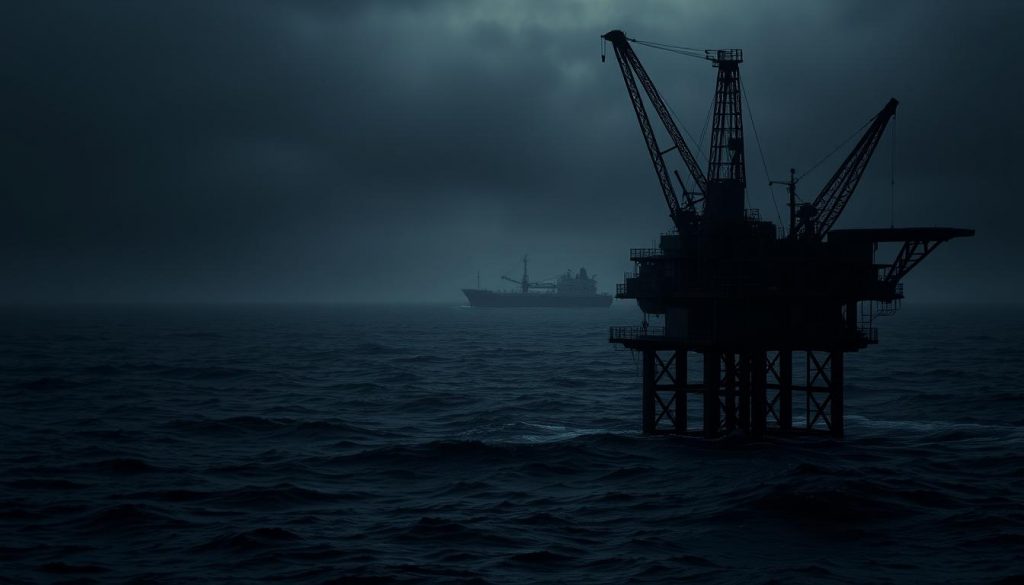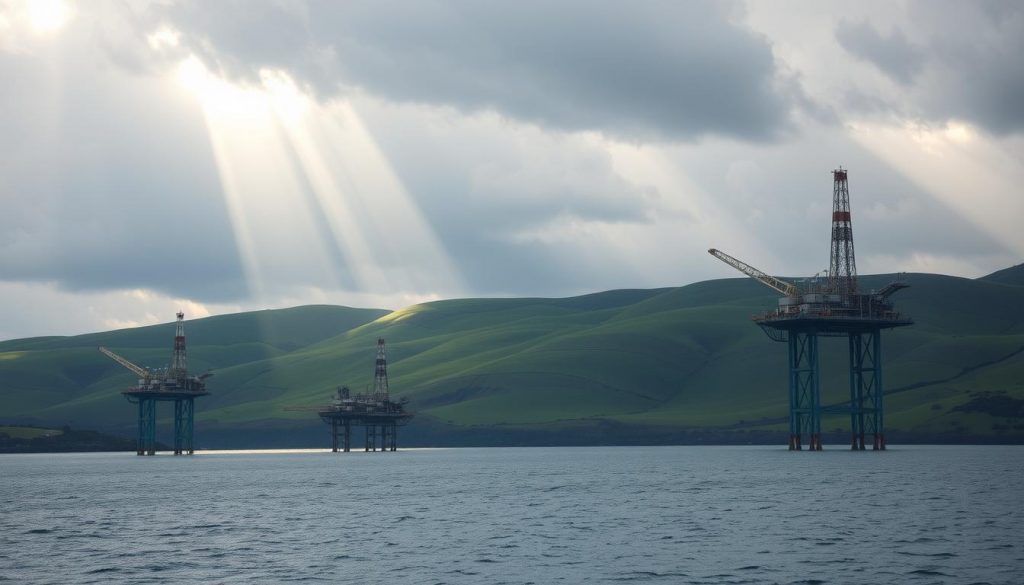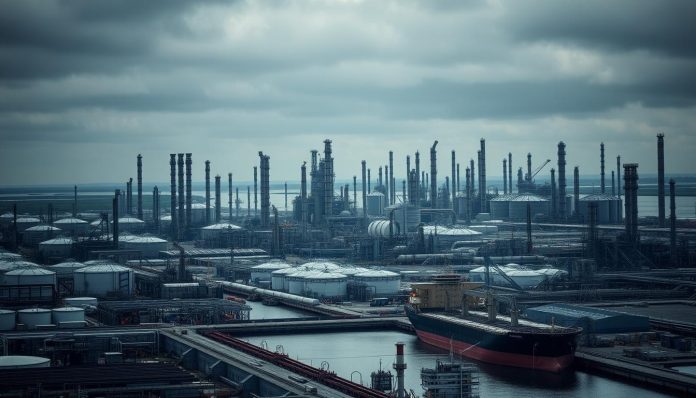Could a policy shift today decide whether the country imports most of its fuel tomorrow? This question matters because a new report warns of a sharp drop in home production and a rise in external supply reliance.
North Sea output reached a historic low in 2024, leaving the nation already dependent on more than 40% of its oil and gas needs. The report suggests reliance could climb sharply without steady investment and clearer policy signals.
Industry groups argue that targeted reforms could unlock reserves and add significant value to the economy. Opponents point to plans for more wind, CCS clusters and limits on new licences as an alternative route.
This introduction sets the scene for a forward-looking analysis. It explains why falling home supply, volatile prices and shifting trade patterns matter for jobs, household bills and the wider economy.
Key Takeaways
- The report links historic low output to rising import exposure and price volatility.
- Policy design — including tax and price mechanisms — will shape future home supply.
- Industry warns of job losses unless investment incentives are reset.
- Clean power, wind build-out and CCS could reduce demand for gas over time.
- Readers will learn the core causes, trade signals and a pragmatic policy option next.
UK economy news snapshot: energy security at a crossroads
Recent declines in North Sea output have shifted the spotlight onto trade flows and household costs.
Latest industry news: North Sea production hits a historic low
The sector reported a historic low in 2024 for north sea production. This drop reduces domestic supply and raises exposure to external markets.
OEUK argues that sizeable reserves remain if a competitive tax and regulatory regime, faster approvals and ongoing licensing return. The energy levy has underperformed on receipts, the industry body warns, deepening investor caution.
Trade news and price signals: how import reliance feeds inflation and bills
Trade data show the country imports about 45% of gas and 44% of refined oil products. Higher global prices and LNG premiums push up domestic prices and household bills.
Gas-fired power has stayed around 88% more expensive than pre-crisis averages and costs rose 33% in 2024. Interconnectors supplied roughly 5% of electricity (2013–2023), helping smooth spikes but not replacing fuel imports.
- Fields are ageing; new finds are smaller and harder to extract, delaying recovery in oil gas production.
- Policy signals now shape capital allocation, cooling the investment pipeline across the sector.
- Higher import shares magnify pass-through from volatile global price moves to UK bills.
| Metric | Recent value | Implication |
|---|---|---|
| North Sea output (2024) | Historic low | Less domestic supply; more import reliance |
| Gas imports | 45% | Exposure to LNG and pipeline price swings |
| Oil product imports | 44% | Higher fuel costs feed inflation |
| Gas-fired power cost change (2024) | +33% | Higher consumer bills and business costs |
The snapshot sets a clear frame: falling home production, pricier imports and a tense policy crossroads. The next sections will probe demand shifts and pragmatic policy options to steady supply and limit inflationary pressure.
The Alarming Forecast: imports rising as North Sea output falls
A sharp shift in supply patterns risks handing the country most of its fuel needs to foreign sources within a decade.
Warning: UK oil and gas imports could soar to 70% by 2030
Headline risk: Current analysis shows the country already meets over 40% of energy needs via imports. Without sustained investment, that share could import the majority by 2030, a pivotal shift for energy security and fiscal resilience.
Historic low in north sea production: investment drought and maturing fields
North sea output hit a historic low in 2024. Ageing platforms, smaller sea oil and sea oil gas finds and a prolonged investment slowdown explain the fall in production.
Import mix and exposure: Norway pipelines vs US/Qatar LNG and tariff risks
Supplies now flow via Norway pipelines and LNG cargoes from the USA, Qatar and others. LNG is typically pricier and more exposed to trade politics and tariffs, raising costs and price volatility.
Consumer impact: gas-linked power prices and bill volatility since the energy crisis
Gas remains central to balancing power. Higher gas costs feed through to electricity prices and household bills.
- Gas-fired generation costs stayed high, around 88% above pre-crisis averages and rose 33% in 2024.
- Greater import exposure can hardwire global shocks into domestic inflation and household costs.
- Interconnectors play an important role in smoothing markets, but bulk exposure sits with fuel commodities.
The Cause: a stifling environment for homegrown production
Tax uncertainty and regulatory delay have raised the cost of capital and slowed project sanctioning across the sector. Instability around the energy profits levy has chilled investor appetite just as the north sea needs sustained investment.
OEUK highlights that the levy has under-delivered revenues and deterred fresh investment. Forecast receipts fell short, and industry leaders say original market conditions that justified the levy have eased.

Lengthy approvals, unclear licensing timetables and layered net zero compliance increase project risk. These delays push first production dates out and raise costs for developers and contractors.
- Policy signals now shape capital allocation, making finance more expensive and slowing recovery.
- The report links the levy to softer investment, delayed field work and higher production costs.
- Regulatory drag — slow permits and overlapping rules — extends project timetables and risk.
“Without clearer fiscal and licensing pathways, suppliers face narrowing pipelines and jobs continue to fall.”
The combined effect risks shrinking domestic production, squeezing the economy and boosting import reliance. Readers can follow the latest industry warning on investment and jobs for more context on approvals, licensing and transition pressures.
UK Oil and Gas Imports May Hit 70% by 2030: Find Out Why! The proposed “pragmatic” policy shift
A targeted reset of rules could mobilise capital into both traditional fields and low‑carbon projects.
Fiscal reset: from windfall tax to price mechanisms
The report recommends replacing the windfall levy with predictable price mechanisms to crowd in investment. That approach aims to unlock more than two billion barrels and roughly £150bn in value, while giving investors clearer returns.
Licensing and timelines: faster approvals
Quicker permits and milestone-based licensing would cut time to first production. Faster approvals stabilise supply trajectories during the transition and make new projects bankable, supporting private investment into both oil and gas and low‑carbon assets.
Demand-side solution: clean power build‑out
Scaling renewables, grid‑scale storage and interconnectors reduces gas demand for electricity. Clean Power 2030 plans, plus storage and trading links, can lower wholesale volatility and shrink costly energy imports over time.

Technology and renewables news: CCS, storage and interconnectors
Sustainable technology projects — CCS clusters, large storage sites and new cables — are moving from concept to finance. This tech-led route supports net zero goals while keeping power quality and security central.
“A stable fiscal signal is the most effective lever to mobilise patient capital.”
For discussion of tax design and spending choices, see the government taxes and spending analysis.
Conclusion: UK Oil and Gas Imports May Hit 70% by 2030: Find Out Why!
The coming years force a trade-off between phasing down fossil fuel reliance and keeping supplies secure. A pragmatic package can let north sea oil, sea oil and sea oil gas bridge demand while clean power grows.
Targeted investment and production discipline in existing fields can curb abrupt decline and limit price shocks. That approach helps protect bills and shields households from external shocks tied to imports oil and fuel.
Government, industry and finance must align quickly. With timely policy certainty, the sector can support a fair transition that balances security, jobs and faster clean energy rollout.
For more articles on Energy, please follow the link


